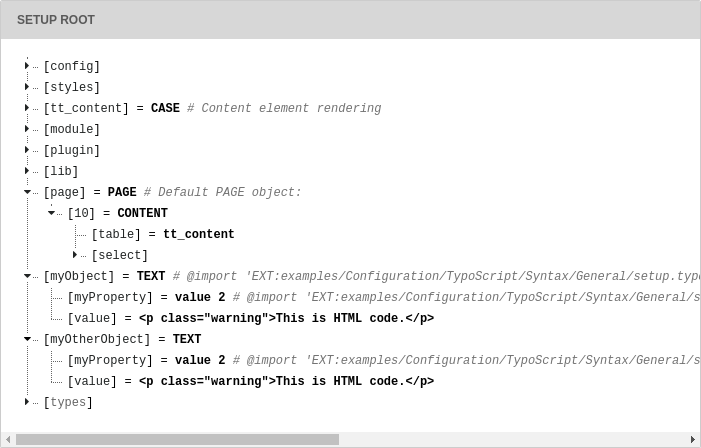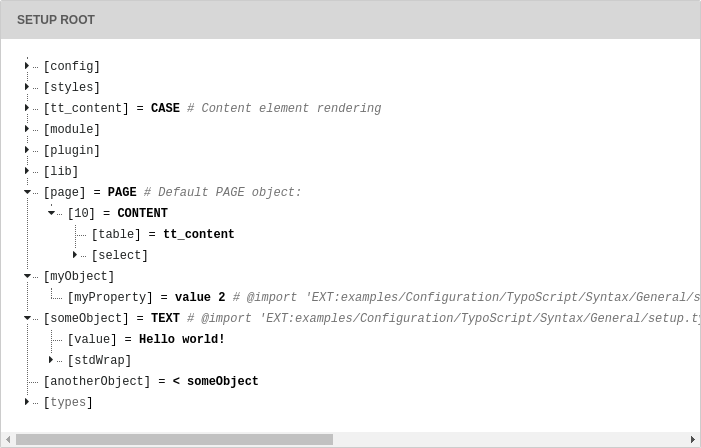Attention
TYPO3 v11 has reached end-of-life as of October 31th 2024 and is no longer being maintained. Use the version switcher on the top left of this page to select documentation for a supported version of TYPO3.
Need more time before upgrading? You can purchase Extended Long Term Support (ELTS) for TYPO3 v11 here: TYPO3 ELTS.
TypoScript syntax
TypoScript is parsed in a very simple way; line by line. This means that abstractly said each line normally contains three parts based on this formula:
[Object Path] [Operator] [Value]Example:
myObject.myProperty = value 2In this example we have the object my with the property my
and a value value 2.
Object path
The object path (in this case my) is like the
variable name in a programming language. The object path is the first
block of non-whitespace characters on a line until one of the
characters =<> or a white space is found. The dot (.) is used
to separate objects and properties from each other creating a hierarchy.
Use only A-Z, a-z, 0-9, "-", "\_" and periods (.) for object paths!
Dots in the object path can be escaped using a backslash.
Escaping example:
my\.escaped\.key = testThis will result in an object named my. with the value "test".
Here we do not have three hierarchically structured objects my,
escaped and key.
Operator
The operator (in the example it is =) can be one of the characters
=<>. The various operators are described below.
Value assignment: The "=" operator
This assigns a value to an object path.
Rules:
Everything after the = sign and up to the end of the line is
considered to be the value. In other words: You don't need to quote
anything!
Be aware that the value will be trimmed, which means stripped of whitespace at both ends.
Value modifications: The ":=" operator
This operator assigns a value to an object path by calling a predefined function which modifies the existing value of the current object path in different ways.
This is very useful when a value should be modified without completely redefining it again.
Rules:
The portion after the := operator and to the end of the line is
split in two parts: A function and a value. The function is specified
right next to the operator (trimmed) and holding the value in parentheses
(not trimmed).
This is the list of predefined functions:
- prependString
- Adds a string to the beginning of the existing value.
- appendString
- Adds a string to the end of the existing value.
- removeString
- Removes a string from the existing value.
- replaceString
- Replaces old with new value. Separate these using
|. - addToList
- Adds a comma-separated list of values to the end of a string value. There is no check for duplicate values, and the list is not sorted in any way.
- removeFromList
- Removes a comma-separated list of values from an existing comma-separated list of values.
- uniqueList
- Removes duplicate entries from a comma-separated list of values.
- reverseList
- Reverses the order of entries in a comma-separated list of values.
- sortList
-
Sorts the entries in a comma-separated list of values. Optional parameters are:
- ascending
- Sort the items in ascending order: First numbers from small to big, then letters in alphabetical order. This is the default method.
- descending
- Sort the items in descending order: First letters in descending order, then numbers from big to small.
- numeric
- Apply numeric sorting: Numbers from small to big, letters sorted after "0".
Multiple parameters are separated by comma.
There is a hook inside class
\TYPO3\
which can be used to define more such functions.
Example:
myObject = TEXT
myObject.value = 1,2,3
myObject.value := addToList(4,5)
myObject.value := removeFromList(2,1)produces the same result as:
myObject = TEXT
myObject.value = 3,4,5Code blocks: The { } signs
Opening and closing curly braces are used to assign many object properties in a simple way at once. It's called a block or nesting of properties.
Rules:
- Everything on the same line as the opening brace (
{), but that comes after it is ignored. - The
}sign must be the first non-space character on a line in order to close the block. Everything on the same line, but after}is ignored. - Blocks can be nested. This is actually recommended for improved readability.
Important
You cannot use conditions inside of braces (except the
[GLOBAL] condition which will be detected and reset the brace-level to
zero)
Note
Excessive end braces are ignored, but generate warnings in the TypoScript parser.
Example:
myObject = TEXT
myObject.stdWrap.field = title
myObject.stdWrap.ifEmpty.data = leveltitle:0could also be written as:
myObject = TEXT
myObject {
stdWrap {
field = title
ifEmpty {
data = leveltitle:0
}
}
}Multi-line values: The ( ) signs
Opening and closing parenthesis are used to assign a multi-line value . With this method you can define values which span several lines and thus include line breaks.
Important
You cannot use multi-line values in constants. They are only available in the setup part of TypoScript.
Rules:
The end-parenthesis is extremely important. If it is not
found, the parser considers the following lines to be part of the
value and does not return to parsing TypoScript. This includes the
[GLOBAL] condition which will not save you in this case! So don't miss
it!
Example:
myObject = TEXT
myObject.value (
<p class="warning">
This is HTML code.
</p>
)Object copying: The "<" sign
The < sign is used to copy one object path to another. The whole
object is copied - both value and properties - and it overrides any
old objects and values at that position.
Example:
myObject = TEXT
myObject.value = <p class="warning">This is HTML code.</p>
myOtherObject < myObjectThe result of the above TypoScript is two independent sets of objects/properties which are exactly the same (duplicates). They are not references to each other but actual copies:

An object and its copy
Another example with a copy within a code block:
pageObj {
10 = TEXT
10.value = <p class="warning">This is HTML code.</p>
20 < pageObj.10
}Here also a copy is made, although inside the page object. Note
that the copied object is referred to with its full path
(page). When copying on the same level, you can
refer to the copied object's name, prepended by a dot.
The following produces the same result as above:
pageObj {
10 = TEXT
10.value = <p class="warning">This is HTML code.</p>
20 < .10
}which – in tree view – translates to:

Another object and its copy
Important
When the original object is changed after copying, the copy does not change! Take a look at the following code:
someObject = TEXT
someObject {
value = Hello world!
stdWrap.wrap = <p>|<p>
}
anotherObject < someObject
someObject.stdWrap.wrap = <h1>|<h1The value of the std property of another
is <p>. It is not <h1> because this change
happens after the copying. This example may seem trivial, but
it's easy to loose the oversight in larger pieces of TypoScript.
Note
If the copy operator does not give you any result, then the reason for this behaviour can be a wrong initialization order of the objects. The original object shall be copied, but it has not been assigned the intended value at this moment. Try to use the equal smaller "=<" sign instead. Then TYPO3 will make the intended object still available after its initialization.
Object references: the equal smaller "=<" sign
In the context of TypoScript Templates it is possible to create references from one object to another. References mean that multiple positions in an object tree can use the same object at another position without making an actual copy of the object but by pointing to the objects full object path.
The obvious advantage is that a change of code to the original object affects all references. It avoids the risk mentioned above with the copy operator to forget that a change at a later point does not affect earlier copies. On the other hand there's the reverse risk: It is easy to forget that changing the original object will have an impact on all references. References are very convenient, but should be used with caution.
Note: Changing or adding attributes in the object holding a reference will not change the original object that was referenced.
Example:
someObject = TEXT
someObject {
value = Hello world!
stdWrap.wrap = <p>|<p>
}
anotherObject =< someObject
someObject.stdWrap.wrap = <h1>|<h1>In this case, the std property of another
will indeed be <h1>. In tree view the properties
of the reference are not shown. Only the reference itself is visible:

An object and a reference to it.
Remember:
- References are only available in TypoScript templates, not in TSconfig (user TSconfig or page TSconfig)
- References are only resolved for Content Objects, otherwise references are
not resolved. For example, you cannot use a
reference
< plugin.to find the value oftx_ example. settings. foo foo. The value you get will be just< plugin.instead.tx_ example. settings. foo
Object unsetting: The ">" Sign
This is used to unset an object and all of its properties.
Example:
myObject = TEXT
myObject.value = <strong> HTML - code </strong>
myObject >In this last line my is totally wiped out (removed).
Conditions: Lines starting with "["
Conditions break the parsing of TypoScript in order to evaluate the content of the condition line. If the evaluation returns true, parsing continues, otherwise the following TypoScript is ignored until the next condition is found, at which point a new evaluation takes place. The next section in this document describes conditions in more details.
Rules:
Conditions apply only when outside of any code block (i.e. outside of any curly braces).
Example:
[date("j") == 9]
page.10.value = It is the 9th day of the month!
[ELSE]
page.10.value = It is NOT the 9th day of the month!
[END]Value
The value (in case of the above example "value 2") is whatever characters follow the operator until the end of the line, but trimmed for whitespace at both ends. Notice that values are not encapsulated in quotes! The value starts after the operator and ends with the line break.
Comments
TypoScript support single line comments as well as multiline comment blocks.
Single line comments
When a line starts with // or # it is considered to be a comment
and will be ignored.
Example:
// This is a comment
myObject = TEXT
myObject.value = <strong>Some HTML code</strong>
# This line also is a comment.Comment blocks
When a line starts with /* or */ it defines the beginning or the
end of a comment section respectively. Anything, excluding imports, inside a comment
section is ignored.
Warning
Imports within a block comment are still resolved. This is true for both imports
with the
@import and
<INCLUDE_
syntax. Always use single line comments to comment out imports.
Rules:
/* and */ must be the very first characters of a trimmed line in
order to be detected.
Comment blocks are not detected inside a multi-line value block (see parenthesis operator below).
Example:
/* This is a comment
.. and this line is within that comment which...
ends here:
*/ ... this is not parsed either though - the whole line is still within the comment
myObject = TEXT
myObject.value (
Here is a multiline value which
/*
This is not a comment because it is inside a multi-line value block
*/
)